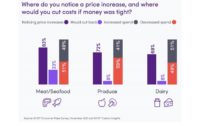Grocery shopping continues to become more and more specialized. For the majority of the population, they want a one-stop shop to buy all their groceries for the week, and the conventional neighborhood supermarket serves that need just fine. Others look for a more specific item, like all-natural beef or GMO-free sausages, and they have specialty grocery stores like Whole Foods and Trader Joe’s. Sometimes, that’s still not enough. A small but rising segment of the population wants to support local farmers and buy the product directly from the person who raised it or grew it. Farmers markets meet that particular need.
While some may think of a farmers market as a home for fruits and vegetables, meat vendors are a popular draw as well. Midan Marketing surveyed 200 people who purchased meat or poultry products at farmers markets within the last year. Twenty-five percent of those respondents said that they are purchasing their meats at a farmers market instead of a grocery store, rather than in addition to what they buy at the store.
Danette Amstein, principal, says that the farmers market provides a more stimulating shopping experience compared to the typical grocery store. A “clean-store” policy, which doesn’t clutter the shopping experience with added information, can actually working against the retailer, as consumers want more information than ever. For shoppers seeking more transparency, a farmers market has distinct advantages over the supermarket.
“Our research shows the #1 reason why consumers purchase meat products from a farmers market is they believe it’s fresher than meat purchased at a traditional retail market,” Amstein says. “The second reason is they believe they have more information about the products that they are purchasing. We know that consumers like to know where meat comes from, and how the animal is cared for, and they really like at the farmers market the opportunity to really talk to the farmer.
“Consumers also purchase meat at farmers markets because they really like to support their local community, which is obviously a growing movement across the country over the last few years,” she adds.
Amstein notes that 77% of consumers surveyed said they were very satisfied with the meat that they purchased, and 37% said they were buying more meat at a farmers market than they were a year ago.
There are those consumers with concerns about the meat they buy at markets. Chief among those concerns is food safety and the lapse in refrigeration in the product. There are also concerns about a perceived lack of inspection of the meat products. Amstein recommends that vendors who sell meat items find a way to address those concerns to put shoppers more at ease.
Farmers markets can be found all over the country, in both rural and urban areas. Green City Market, which is entering its 17th season, is located in the heart of Chicago, right by the city’s famed Lincoln Park Zoo. During the summer, it is open on Wednesday and Saturday mornings.
Green City Market was founded with the idea of connecting Midwest farmers to chefs and consumers in the Chicagoland area. Executive Director Melissa Flynn says that meat producers come from Illinois, Wisconsin and Michigan to sell their products, as well as a shrimp farmer from Indiana.
Even in the center of one of the country’s largest urban areas, there are plenty of consumers who are interested in the stories behind the food they eat.
“We’re blessed with having a great audience for this, and a lot of people who really are interested in agriculture and feeding themselves and their families better,” Flynn says.
Good communication skills are important for vendors. Flynn, who shopped at Green City Market before becoming executive director, says that she likes looking at the stalls and talking with the farmers. It could be about a certain vegetable or a particular cut of meat, and the conversation could be enough to get her to take that product home.
“Oftentimes, I’m looking for something that will catch my eye – something I may not even know what to do with, and then having that conversation,” she says.
For vendors, a farmers market is an opportunity to market directly to the consumer, particularly with product that can’t compete with lower-cost commodity items in a supermarket meat case. Nate and Lou Ann Robinson were commercial hog farmers for many years before they decided to downsize and market their pork products directly to consumers as Jake’s Country Meats.
Lou Ann says that the business, located in Cassopolis, Mich., has been selling at farmers markets for over 15 years. In addition to the Green City Market, they go to other markets in the Chicago area as well as ones in southwest Michigan.
“You talk directly to the consumer, you know what they are looking for, you learn what they are interested in, and you can take that back to the farm and make it happen,” she says. “When you talk directly to the consumer, you have a better relationship.”
Jake’s Country Meats does have a great story to tell, and the interaction at a farmers market is a perfect way to convey it to consumers. Nate Robinson is a sixth-generation farmer, and the Robinson’s children and grandchildren work on the farm, adding the seventh and eighth generations. The pork products are all pasture-raised, antibiotic-free and Animal Welfare Approved.
“We always knew we had a great product; we just never felt we were getting paid for it through the conventional market. This works much better for us,” Lou Ann says.
Along with the successful line of pork products, Jake’s sells fish from the Great Lakes. The company works with a biologist in the Upper Peninsula who in turn works with the Ojibwa Native American fishermen in the area to supply whitefish, perch, lake trout, salmon and walleye.
“We can tell you where all our fish are caught, and most of the time we can tell you which fisherman did the catching,” Lou Ann says.
Jake’s also sells through wholesale accounts and on-farm sales. The Robinsons recently added chicken, turkey and Scottish Highland cattle to the farm to expand its portfolio.
Lou Ann notes that shoppers like to come to farmers markets just so they can talk with the farmer about the meats or the vegetables that they’re buying. All too often, though, the farmers don’t come to the market and instead send an employee. For that reason, at least one member of the Robinson family attends most markets, so shoppers can gain that connection with the family. It’s a way to build loyalty, she says.
“They stay with you. They’ll ride the waves of pricing and product availability and things like that, because they are in tune to what the farmer is doing,” she adds.
Heartland Meats, located in Mendota, Ill. has a similar story. Pat and John Sondgeroth raised commodity beef before deciding to direct market to consumers. Their beef comes from the Piedmontese breed, which is known for its leanness and tenderness.
The company also operates its own on-site processing plant. Heartland Meats does not harvest the beef, but it cuts and packages all its products. Pat explains that as they were putting their business plan together, they had problems with getting a consistent product back from some local slaughterhouses. They also had questions about whether all of the meat was from their cattle.
“When we are making label claims that we are all-natural and raised without antibiotics and are Piedmontese beef, we knew that we absolutely had to have consistency and some kind of guarantee that it was our beef and only our beef,” Pat says. “That led us to the direction of processing our own in order to control quality and consistency.”
Heartland Meats sells to small grocery stores and local restaurants and can ship product, but the farmers markets are its most successful marketing venue.
“It is the most effective way for us to move our unique product,” Pat says. “By doing the processing ourselves on the scale we are doing it, it’s expensive. But, through the farmers markets we can achieve the price needed to make this profitable.”
Pat notes that for companies that wish to sell at farmers markets, they first have to apply to become a vendor, and the regulations for markets can vary. Some traditional markets require that the vendors are the farmers who raised the crops or the animals. In that instance, a small processor couldn’t be a vendor, even if it sold products from locally sourced animals. Other markets are more like public markets, where local companies of all kinds are welcome.
Beyond that, old-fashioned customer service is critical to gaining sales and repeat customers. People who stop by Heartland Meats can have all their questions answered and even get recommendations based on their particular need. It’s a good way to publicize the lesser-known cuts of meat as well.
“When you see a coulotte steak at a grocery store – if you see a coulotte steak at a grocery store meat counter – you would have no idea where that cut came from or how to prepare it,” she says. “[Here] you can get those questions answered immediately.”







Report Abusive Comment